A dog whistle is a great investment for training and recall. Different pitches and rhythms can indicate a variety of commands.
A quick toot of the whistle is a great way to grab your dog’s attention when they’re out of sight or out of earshot. At a frequency range of 16,000–22,000 Hz, the sound of a dog whistle can travel greater distances than voice commands or shout, in any terrain or situation.
When searching for the perfect dog whistle online, you must consider what you’ll use it for. Do you need it for basic whistle-training? Competing in field trials? Hunting? Your dog’s breed and age are other decision-making factors.
Best Silent Dog Whistles to Buy in 2022!
1. Acme 210.5 and Acme 211.5 Dog Training Whistle
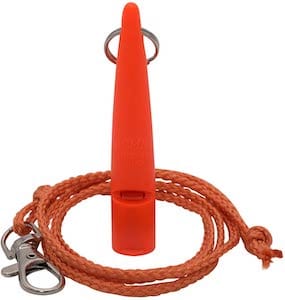
Hands down, Acme makes the best dog whistles in the UK market, and they’re reasonably priced too.
Acme 210.5 and Acme 211.5 are the two best and most effective dog training whistles in UK’s 2022 market. You can buy either, depending on your dog’s breed. Acme has created a stable dog whistle sound in the frequency 4850 Hz. And it comes in 20 different colours.
Of course, it’s not the most silent for human ears compared to other options, but it certainly isn’t deafening. This is an ideal option for sport, hunting and herding. This whistle is also suitable for dog trainers to guide and rescue dogs.
Overall, if you’re looking for a basic dog whistle to support training and recall, with the bonus of a wide colour selection and competitive price point, I highly recommend this one.
Buy Acme 210.5 Dog Training Whistle on:
Buy Acme 211.5 Dog Training Whistle on:
2. QUACOWW Dog Training Set
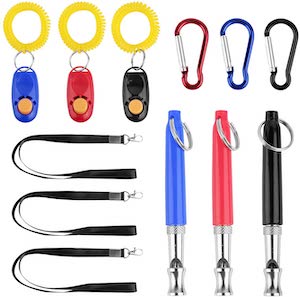
The second place goes to the Quacoww set. This nine-piece training set comes with three whistles for dogs and some additional pieces to support your training journey.
You get three training whistles with lanyards, three training clickers with wrist straps and three spring snap hooks. A fantastic feature is that you can adjust the whistle sounds to multiple frequencies. It can be used to easily train your puppy with unlimited commands as they will associate different frequencies with different instructions.
The whistles and hooks are made from stainless steel, the clicker is made from plastic, and the lanyards are nylon. All of the items within the pack are durable, firm, lightweight and portable.
Buy QUACOWW Dog Training Set on Amazon
3. Ueetek Training Clicker and Whistle
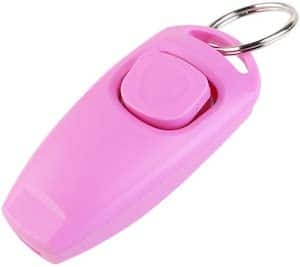
It’s the best dog training whistle and clicker combined. The whistle and clicker device is on a keyring ideal for outdoor adventures.
If you’re keen to start training your puppy, then this is great as you can use the clicker for one command – perhaps as a way of saying ‘no’ to undesirable behaviour and the whistle to recall your dog when they are off their lead to save you shouting across the field.
Ueetek’s Training Clicker and Whistle is certainly not the fanciest product on the list, but it does the job, has the additional clicker feature and is reasonably priced.
4. forePets Professional WhistCall
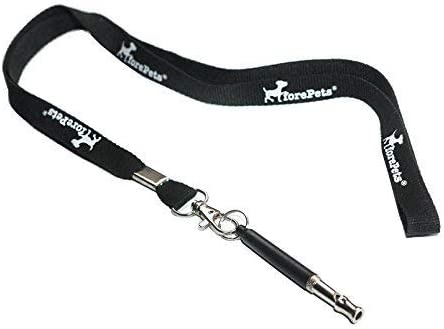
WhistCall Bark Control & Obedience Training Dog Whistle by forePets is a great alternative to the Ueetek if you want adjustable frequency. It only costs a little more and is just as good. Of course, you won’t have a clicker anymore if you choose this.
Like Ueetek, it’s a reasonably-priced product with acceptable build quality and lanyard. You only have to choose between a clicker and an adjustable frequency feature.
Why should you use a dog whistle?
Of course, you don’t HAVE to use a dog whistle, silent or not. Most dog owners train their household pets with voice commands; technically, you can too. It’s cheaper and easier since you already know how to communicate with your furry ball of energy.
That said, there are some obvious benefits to using a dog whistle over verbal commands.
- A dog’s hearing is much sharper than a human’s, so they can “understand” the changes in your tone more than you think. With a whistle, your dog can’t tell if you’re panicking or not.
- A dog whistle’s range is much longer than your vocal range. This way, you can communicate with your doggo around the park without straining your vocal cords.
- A dog whistle is just the right balance between unique and common. Your dog will hear not only yours but other people’s voices throughout the day which might make them confused during training. But a whistle will sound the same despite the person blowing it.
How do you introduce a dog whistle?
Dog whistles operate using ultrasonic sound, mostly silent to humans, but animals such as dogs and cats can hear. This makes them an ideal tool for non-intrusive training at all times during the day without impacting others negatively.
However, remember that if your dog can hear it, other dogs can too, so be aware when using it in public places where other dogs can be, as you may end up with more than one returning to you when you blow!
Let’s start the training, shall we?

1. What are the whistle commands for a dog?
There are two whistle commands that your dog needs to master – sit and recall. The sit command is usually associated with a long blow into the whistle. And recall command is taught using multiple small but consecutive blows into the whistle.
When it comes to whistle training your dog, there are two tenets that you must never break. First, ALWAYS reward lavishly.
Second, never set your dog up to fail. Never use the whistle until you’re sure the dog will follow the command. The goal is to encourage the behaviour, not take a test.
2. How do you teach a dog recall?
You should teach your dog recall first since it’s easier to associate and thus master. The trick to recall training is to associate the whistle call with good things. If you can make your dog believe that the whistle call means something good is happening, they’ll rush over to you as quickly as they can.
Training sound: Multiple short and continuous bursts.
Step 1: Association.
Condition your dog to recognize the sound when good things happen. Blow multiple whistle bursts during mealtime or when you’re going out to walk/play. Use the whistle every time your dog is doing something they love.
Are they playing with their favourite toy? Whistle away.
Step 2: Take a small and simple test.
Once you’re sure about the association, take a small test. But don’t set them up to fail. Make sure your dog has no distractions and can hear you properly. Stand in front of the dog so they can see you and blow into the whistle.
If your dog comes back, reward them luxuriously. If they don’t, stop whistling immediately and work on the association. Don’t continue to whistle, or it’ll be associated with something else entirely.
Step 3: Test two, but they can’t see you.
Take a similar test, but your dog can neither see nor pay attention to you this time. Don’t take the test outside. It’s still too soon.
Blow into the whistle and reward properly if they come back.
Step 4: Test in public but without distractions.
Now, it’s time to test in public but make sure your dog will have no distractions when they run back to you. Reward lavishly once they come back.
Step 5: Increase the distance slowly.
Start increasing the distance slowly but never set them up to fail. Let it become a habit.
Read More: Symptoms, Causes & Treatments for Heavy Breathing & Panting in Dogs
3. How do you train a dog to sit on a whistle?
Your dog should already be accustomed to the whistle now, so making them sit should be easier. The final goal is to make them sit even from a distance.
Training sound: One long burst.
Step 1: Teach the verbal “sit.”
It’s downright impossible to associate a sound with sitting. First, teach your dog the verbal “Sit” command using hand gestures.
Step 2: Associate whistle with the command.
Next, slowly transition to the dog whistle by blowing into the whistle while giving the command. Start rewarding once your dog begins associating the two together.
Step 3: Move away from verbal command.
Slowly transition out of the verbal command and depend solely on the whistle. Again, reward luxuriously if your dog obeys the association.
Step 4: Add some distance.
Give the command with your dog whistle and reward if they comply. If they come running to you, give both commands – verbal and whistle from a distance.
Step 5: Mix both commands.
The final test is first to make your dog sit from a distance so you have their full attention. Next, recall and get them back to you. And finally, get them to sit in front of you.
Reward lavishly once they perform all three in order.
Ps…the sit command is handy to grab your dog’s attention and get them to stop barking.
Keep practicing!
How to choose the best dog whistle?
Choosing the correct dog whistle for your dog depends on two major factors – their breed and age. Some breeds respond better to a 210.5 whistle pitch, while others prefer a 211.5.
Your dog’s age determines the frequency of the whistle. As the pooch ages, a dog whistle calibrated for adults can go from mildly irritating to a major issue. So, it’s important to ensure you find the right frequency for your dog.
The most effective way is to purchase a dog whistle with adjustable frequency, after which it’s just a case of simple trial and error.
Remember that if you purchase a dog whistle with a single frequency and it’s the wrong one, it will, unfortunately, be sent back or go into the bin.
Next, choose a whistle that matches you and your furry friend’s lifestyle. Is it going to be used indoors only? If so, you won’t need an expensive and tough one. But if you like to go on adventurous walks or even hiking, it’s best to get one with a lanyard built robustly.
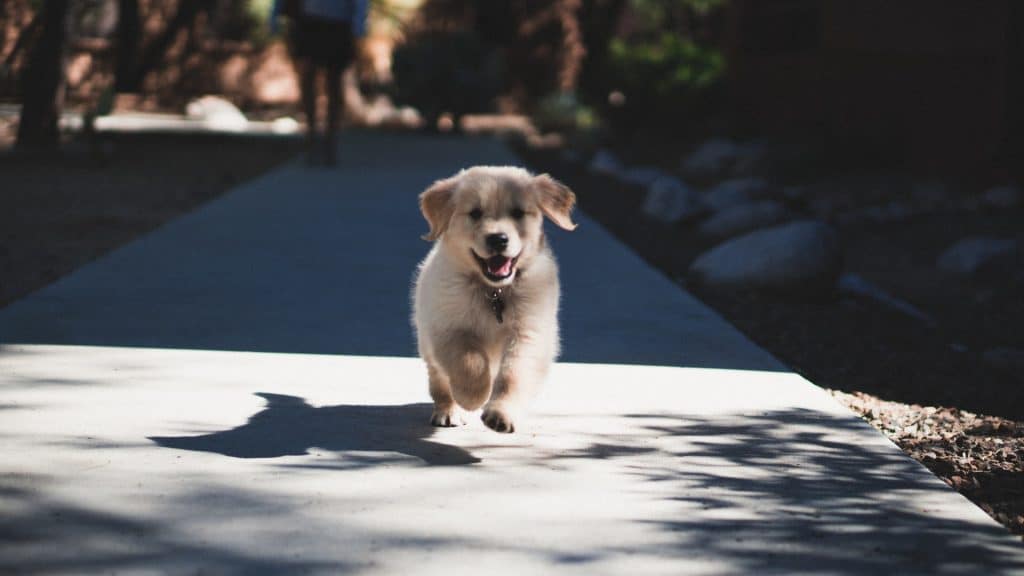
Frequently Asked Questions (FAQs)
1. What is the effective range of a dog whistle?
The effective range of a standard dog whistle is approximately 0.22 to 0.93 miles (400 – 1640 yards). The long-range silent whistles are specially made for hunting dogs and are mostly inaudible to humans. The short-range whistles, like Acme, are for household pets.
2. What frequency is the most effective for a dog whistle?
A good frequency for a dog whistle depends on the desired results and your dog’s hearing ability. Ideally, the best frequency is between 20 and 45 kHz. You can purchase adjustable whistles that can be fine-tuned for testing your dog’s reaction and response.
Do consider that higher frequencies may be more irritating for the dog and can be used as a punishment, and a lower frequency may not bother them at all. Our advice is to keep the frequency low between 25 – 35 kHz.
Read More: Everything Dogowner Should Know About Clipping Nails
3. Does whistling hurt dogs’ ears?
Dog whistles won’t hurt your doggo’s ears, provided you use them correctly. These ultrasonic whistles are generally made to produce sounds that might irritate your dog’s ears to demote negative behaviour.
4. Do ultrasonic anti-bark dog devices work?
This question has been plaguing the dog-owner community for some time now. Should you use an anti-bark device on your dog? Or are they simply cruel?
Some ultrasonic anti-bark devices are effective and even useful in training dogs who bark excessively. However, the use of shock collars is strongly discouraged from the three major anti-bark device types – ultrasonic sound emitter, spray collar, and shock collar.
5. Will a dog whistle hurt a cat’s ears?
This is where things get a little weird. Cats can hear the whistle, but they don’t care. Classic cats!
Dog whistles produce ultrasonic sound at 23 Hz to 54 kHz, which cats can hear even better than dogs. Cats can hear upto 75 kHz after all. However, cats are seemingly unaffected by these whistles made to irritate a dog and demote negative behaviours.
6. What is the difference between a 210.5 and 211.5 whistle?
Dog whistles are made in two types of pitches – 210.5 and 211.5. As humans, the small margin makes no difference to us, but it’s a big deal for dogs.
A 210.5 dog whistle is high-pitched and made to work with spaniel breeds. It’s a general-purpose whistle suitable for all dogs, including senior and hard-of-hearing. In comparison, 211.5 dog whistles are comparatively low-pitched and suited for retriever and labrador breeds.
7. Is there a dog whistle for hard-of-hearing dogs?
Some dog whistles like the Gusiwhoo 2 have adjustable frequencies, which are suitable for disabled and senior dogs. A fine-tuned ultrasonic whistle can be heard by hard-of-hearing or deaf dogs.





